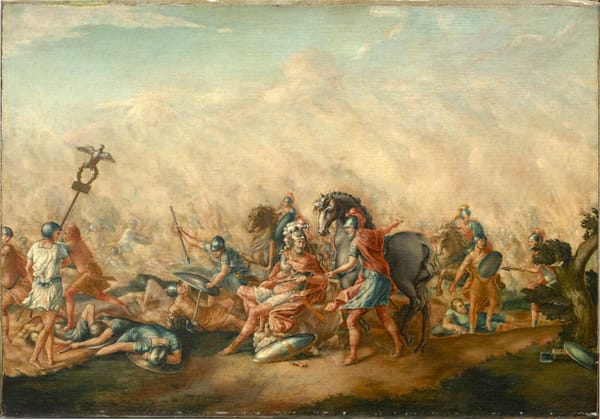Head Coverings in Worship: Answering Uri Brito
Up until very recently, this was the near-universal practice of the church throughout her history.

As the New Christian Right expands, more and more people are returning to the beliefs and practices of their forefathers. One of these practices is the female head covering, that according to 1 Corinthians 11:1-16, women must have a physical covering over their head during the regular gathering for worship. Up until very recently, this was the near-universal practice of the church throughout her history, regardless of denomination. Given that the discarding of this practice coincided with the rise of feminism, many Christians have rightly seen that the plain reading of the text and the practice of the historic church mandate that this practice be revived.
Despite this, many ostensibly conservative Christian pastors remain resistant to this practice. One of these pastors is Uri Brito, the Presiding Minister of the Communion of Reformed Evangelical Churches (CREC). Rev. Brito is known for his ardent opposition to head coverings, writing regularly on various blogs and posting on X in an attempt to stem the rising tide of its resurgence. In this article, we will be responding to a blog post, where he outlines nine theses against the practice, and we will show from Scripture and the witness of the early church and Reformed fathers how he is in error.
In Thesis 1, he writes:
I see the creation argument from which Paul draws his case, offering no substance to the idea/necessity of physical veils/coverings in the context of worship. The creational paradigm involves establishing male/female roles in the Church and the world.
Although much more will be said refuting this assertion further in this article, it is evident from the passage that physical veils are required in worship because of creation:
But I would have you know, that the head of every man is Christ; and the head of the woman is the man; and the head of Christ is God. Every man praying or prophesying, having his head covered, dishonoureth his head. But every woman that prayeth or prophesieth with her head uncovered dishonoureth her head: for that is even all one as if she were shaven. (1 Corinthians 11:3-5)
As a woman is praying during worship, it naturally follows that a head covering is required. Although this certainly flows from the male and female creational roles, it has a specific application in this passage. The order of male and female is the creational reason why a woman must be veiled during worship. A woman’s role is one of submission to her husband—she is not a free agent or in a relationship of complete equality to man.
In Theses 2 and 3, he attacks the symbolism of the physical veil:
The symbolism for “hair” in the Bible is richer than that of a physical veil; the symbolism alone is sufficient, especially when drawn from a rich pattern in creation and Old Testament writings. Hair signifies strength and honor. It is directly connected with ceremonial and liturgical rituals in the Torah. It is further the very root of the Nazirite vow, indicating dedication and glory.
Veiling is impractical and redundant in the context of the explicit theology of “hair” throughout the Scriptures; hair is already glory. There is no need to add another layer to the glory already given to the woman in her hair. It would be akin to adding merit to nature.
In this respect, Brito is correct to conclude that hair signifies strength and honor, and this is the very reason why it must be covered for a woman during worship, as “every woman that prayeth or prophesieth with her head uncovered dishonoureth her head” (v. 5). Through veiling, a woman demonstrates her subjection to her father or her husband as her covenant head. Calvin writes, “if the woman uncovers her head, she shakes off subjection—involving contempt of her husband.” As woman was created for man (v. 9), a symbol of this must be demonstrated in worship in accordance with Paul’s clear command.
Brito also fails to understand the necessity of “another layer.” Wearing a head covering is not akin to adding merit to nature, as he claims. The added layer to the glory is done in order to cover the glory. Paul writes in v. 15, “But if a woman have long hair, it is a glory to her: for her hair is given her for a covering.” Although one may contend here that the hair is the covering, the context of the passage makes the interpretation clear. A woman has long hair to cover herself, else she be shamed if she is shorn (vv. 5–6). John Chrysostom further explains, “And if it be given her for a covering, say you, wherefore need she add another covering? That not nature only, but also her own will may have part in her acknowledgment of subjection.”
Brito continues arguing from history in Thesis 4, noting in looking at the “historical background,” “there were no practices of veiled women in the first-century context.”
This argument is tenuous at best, as limited ancient records from that period are extant and one could just as easily make the argument from silence to conclude that the practice was widespread and not controversial, especially as he does not argue that evidence exists that head coverings were not practiced.
Although it does not appear we have non-biblical sources proving this was practiced in the first century, we do have evidence that it was the practice of the church in the following centuries. Tertullian argues that every “woman of every age, of rank, of every condition” must veil. Clement of Alexandria further shows that “it is becoming for her to pray veiled.” Hippolytus of Rome writes, “And let all the women have their heads covered with an opaque cloth, not with a veil of thin linen, for this is not a true covering.” As these men lived and served in the second and third centuries, we can demonstrate that this was the practice of the earliest Christians after apostolic times.
In Thesis 5, Brito argues from the wider context of 1 Corinthians:
Chapters 11–14 come as a whole. Therefore, there are concerns about the validity of “gifts” beyond AD 70 in a cessationist framework. Why would the apostle state that women wear physical coverings if he knew the gift of tongues and prophecy would cease with the apostolic era?
Here he indirectly refers to verse 5, which reads, “But every woman that prayeth or prophesieth with her head uncovered dishonoureth her head: for that is even all one as if she were shaven.” Although prophecy does cease in the cessationist framework, prayer and the gathered worship of the saints does not, so the ceasing of the apostolic gifts has no relevancy for the applicability of this command in our day; the command for head covering is still in place for Christian women.
He also cites the absence of female head coverings in the Old Testament in Thesis 6, saying:
We affirm Pauline continuity with the Old, so what do we do with priestly turbans and coverings in the Old Testament for men? Why would Paul change the etiquette of the Church suddenly? There are no references to females wearing coverings in the Old in the context of worship, so if creation is the pattern, why wouldn't it be already applied in principle or liturgical form? The pattern for Paul is that man is the head. He is the priestly figure. For the woman to wear a covering would be to reverse the roles.
Although this may initially seem like a compelling refutation, closer examination shows that this is insufficient to refute the practice, as he has not demonstrated that head coverings were not practiced in the Old Testament—merely that turbans were only worn by the priest. We do see that Rebekah veiled herself in public out of reverence for her future husband in Genesis 24:65, so one could reasonably conclude that women would do the same during worship.
Next, he argues in Thesis 7 that because the command is not reiterated in other places where Paul may have had opportune time to mention, the command does not apply, as “[he] had an excellent opportunity to elaborate on this in 1 Timothy 2. Still, he does not refer to head coverings when speaking of female modesty. Instead, he argues that women should avoid unnecessary decorations on their hair.”
The absurdity of this assertion should be evident to any Christian, and it is doubly shameful for a minister. If Christ gives us a command only once in Scripture, it is binding on the Christian because Christ has given us a command. Repetition is not what makes it binding upon us. This is the equivalent of saying that when Jesus blessed the children in Matthew 19 and Mark 10 and did not tell them to honor and obey their parents in the Lord, that they were not obligated to do so.
Brito returns to the historical arguments in Thesis 8, noting that there is not universal agreement through church history on the issue, with notable exceptions, such as Theodore Beza, who viewed the practice as cultural. It’s important to note that head coverings advocates traditionally do not argue that there was universal agreement on the practice up until recently—merely that it has been the majority view through the church’s history. Similarly, infant baptism has been the majority view, yet a minority of credobaptists have existed through the church’s history as well.
His final thesis is by far the most troubling:
Finally, physical head coverings pose a theological threat because they assume Christ's covering as HEAD is insufficient. My primary argument against “head coverings” is that they minimize the role of Christ's covering over both male and female. Thus, female head coverings are outwardly redundant and theologically unhelpful.
Here, Pastor Brito fails to understand basic biblical headship as outlined in Scripture and set so clearly in this passage. Verse 3 reads, “But I would have you know, that the head of every man is Christ; and the head of the woman is the man; and the head of Christ is God.” Although Christ is certainly the head of Christians, we see that there is a hierarchy of headship. God the Father is the head of Christ as Mediator, Christ is head over the man, and the man is the head of woman. Calvin explains:
Here…he reasons respecting outward propriety and decorum—which is a part of ecclesiastical polity…. [A]s regards external arrangement and political decorum, the man follows Christ and the woman the man, so that they are not upon the same footing, but, on the contrary, this inequality exists.
Although Christ is certainly head over all, God has an ordered hierarchy throughout all of creation. Men are not headless. Christ is head over man, man is head over woman, and parents are heads over their children. Given this ordering, when we come into God’s presence, he has commanded that the woman maintain a posture of submission to her covenant head, which is done through the physical head covering, else she “dishonoureth her head” (v. 5). As Calvin says on this verse, “If the woman uncovers her head, she shakes off subjection—involving contempt of her husband.” As someone who claims to hold to biblical patriarchy, Pastor Brito ought to understand this, making such an error even more inexcusable.
Paul concludes his argument in v. 16: “But if any man seem to be contentious, we have no such custom, neither the churches of God.” Pastor Brito is one such man, who not only departs from the biblical pattern and the practice of the historic church personally, but goes so far as to explicitly forbid the practice of members of his own congregation (seen here and here) . He has made a name for himself in violently striving against this practice far beyond what is common today. Charles Hodge gives wise guidance on what to do in these situations:
The arguments against the custom of women appearing in public unveiled having been presented, the apostle says, if any man, notwithstanding these arguments, is disposed to dispute the matter, or appears to be contentious, we have only further to say, that we (the apostles) have no such custom, neither have the churches of God. To be contentious, i.e. disposed to dispute for the sake of disputation. With such persons all argument is useless. Authority is the only end of controversy with such disturbers of the peace. The authority here adduced is that of the apostles and of the churches…No man is justified, except on clearly scriptural grounds, and from the necessity of obeying God rather than man, to depart from the established usages of the church in matters of public concern.
It is the duty of the church in such cases to silence the arguments of such men so that they not mislead the flock into their errors. May God strengthen his church so that we might cast down imaginations, and every high thing that exalteth itself against the knowledge of God, and bring into captivity every thought to the obedience of Christ (2 Corinthians 10:5).
ATTENTION READER: We need your help.
Institutional trust is at record lows. But without institutions, we cannot renew our people, much less provide an inheritance to posterity. In response to this crisis and as an organic outgrowth both of necessity and natural interest, American Mantle exists, not only as a publication for Protestant, right-wing material, but also as a human project with real-world costs. And so we make our appeal.
Donate to the Cause. Help us reach our monthly goal in order to solidify this crucial institution.






